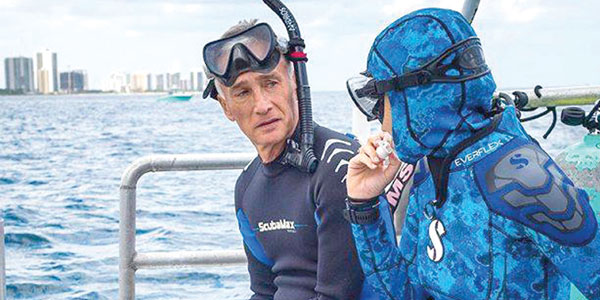
By Jorge Ramos
JUPITER, Fla. — First, the good news: I swam next to a shark without getting hurt.
Now the bad news: Each year roughly 100 million sharks are killed, lowering the global population of the animals to dangerously depleted levels.
My plan was simple. I wanted to write a story about the myth that sharks are violent killers. To do so, I enlisted the help of Julie Andersen, the founder of Shark Angels, a nonprofit conservation group, and a longtime activist. Julie has spent the last 15 years warning people about the consequences of hunting this magnificent and endangered marine predator. She is the best publicist a shark could ask for. “They should be treated with respect,” she told me.
As for any fears I might have? “Don’t you worry at all,” Julie reassured me. “We are not on their menu.”
My team and I headed to the town of Jupiter, about an hour and a half north of Miami up the Florida coast, where lots of companies offer daily shark-diving excursions. Shark diving is not as dangerous as you might think. After all, if the sharks went around eating tourists, these diving businesses wouldn’t last very long.
Still, there was a problem. The night before we arrived, a huge storm had scared off all the harmless lemon sharks we were supposed to film for our story. So Julie and I were forced to venture out into the deeper waters off the coast, to find what sharks remained. A bloody chunk of fresh fish would serve as our bait.
Outfitted with masks and fins, I jumped into the water, close behind Julie. Though she had only good things to say about sharks (“They won’t attack you”) and had told me how to avoid any trouble (“Don’t touch them”), I was feeling a bit uneasy about the prospect of a face-to-face encounter with a shark in the Atlantic.
I had little time to worry. After only a few minutes, we spotted one. It was nothing like what I expected: The shark emerged from the deep sea and headed straight for the bait, which we had stored inside a little plastic crate. It was a 10-foot-long bull shark. From my research, I knew we had summoned up one of the most dangerous shark species in the world.
I stayed still, my body nearly paralyzed and my eyes fixed on the shark, while I floated at the water’s surface. Julie calmly took a deep breath and dove down, effortlessly moving toward the shark. The pair seemed to greet each other. Then, in a sort of dance, they began swimming in circles. They continued harmoniously for a few seconds before the dark-gray creature disappeared.
And that was it. Once I regained my composure back on the boat, the only thing I could think of was how grateful I was for my brief encounter with the shark, as well as the gorgeous sunset that accompanied it. (You can watch our report here.)
Sharks are in urgent need of an image makeover. The 1975 blockbuster “Jaws” portrayed them as brutal assassins who attack people without provocation. The distorted image was further spread by a sensationalist press that reflexively jumps on any story involving a shark, no matter how inconsequential.
This notion of sharks as merciless killers couldn’t be further from the truth. In 2018 only five people around the world died as a result of shark attacks, according to a detailed report prepared by the Florida Museum of Natural History. There were only 66 unprovoked shark attacks in 2018, a slight drop from previous years.
In contrast, humans kill many millions of sharks every year, largely for their fins. In Asia, the traditional dish known as shark fin soup is believed to have healing powers, including the ability to increase stamina and even fight off cancer. None of this is true. Even so, shark fins can be sold for hundreds of dollars per pound.
Sharks endure great hardship. The most complete study conducted to date, published by the British journal Marine Policy in 2013, suggests that approximately 100 million sharks are killed each year as a result of fishing (though the total could range between 63 million and 273 million). Between 6.4% and 7.9% of the global shark population is killed each year, a level that exceeds the animal’s annual breeding rate, estimated at 4.9%. If sharks continue to be slaughtered at this rate, they will disappear completely in less than a century.
Most of us are scared of sharks. In reality, however, sharks have far more reason to be afraid of us. For every person killed by a shark, we kill approximately 20 million of them. Humans, it turns out, are the real brutal assassins.
_______________________________________________________________________
El Tiburón y Yo
JÚPITER, Fla. — Primero la buena noticia: Nadé junto a un tiburón y no pasó nada. Ahora, la mala: Cada año matan alrededor de 100 millones de tiburones y, al hacerlo, está disminuyendo peligrosamente su población a nivel mundial.
El plan era muy sencillo. Queríamos hacer un reportaje sobre los mitos que dicen que los tiburones son seres violentos, y nuestra guía sería la activista Julie Andersen, quien ha dedicado los últimos 15 años de su vida a denunciar la caza de este magnífico y amenazado depredador marino. Julie, fundadora de la organización sin ánimo de lucro llamada Shark Angels, es una de las más efectivas agentes de relaciones públicas que podrían tener los tiburones. Hay que tratarlos con “respeto”, me dijo. No hay que tener miedo de ellos, aseguró: “No somos parte de su menú”.
Llegamos a la población costera de Júpiter, en el sur de la Florida — aproximadamente a una hora y media al norte de Miami — donde varias compañías llevan todos los días a turistas a nadar con tiburones. Es menos arriesgado de lo que parece. Si los tiburones se comieran a sus clientes, este negocio no hubiera sobrevivido por mucho tiempo.
Pero había un problema. La noche anterior a nuestro viaje hubo una poderosa tormenta que alejó a los inofensivos tiburones limón que íbamos a filmar para nuestro reportaje. Los buscamos un par de horas y no encontramos ninguno. Julie y yo nos fuimos a aguas más profundas a encontrar los tiburones que quedaban. La sangre de un pedazo de pescado fresco era la carnada perfecta.
Brinqué al agua con visor y aletas, y seguí a Julie. A pesar de las bondades que me había contado sobre los tiburones (“No te van a atacar”) y sus instrucciones (“No los toques”) tenía miedo de encontrarme, a solas, con un tiburón en pleno océano Atlántico. Y tal y como había dicho Julie, a los pocos minutos apareció un tiburón. Venía del fondo, en dirección a la carnada que guardábamos dentro de una caja de plástico. Era un tiburón toro de 10 pies de largo (unos 3 metros) y, según recordaba de mi investigación, uno de los más peligrosos del mundo.
Me quedé casi paralizado, flotando en la superficie, pero sin perderle la vista al tiburón. En cambio Julie tomó una bocanada de aire, se sumergió sin esfuerzo y suavemente se acercó al tiburón. Los dos se reconocieron y, con cierta armonía, nadaron en círculos por unos segundos hasta que el animal gris oscuro desapareció.
Eso fue todo. Ya en el barco y sin nervios, agradecí el sol de la tarde y el brevísimo encuentro con el tiburón. (Aquí está el reportaje que filmamos: https://bit.ly/2xgHn24.)
Pero me quedo con esto: Los tiburones necesitan un cambio de imagen. La película “Jaws” del 1975 hizo un daño terrible a la percepción pública de los tiburones, presentándolos como brutales asesinos que atacaban a la gente sin provocación. Esa distorsionada reputación se ha extendido por los exagerados reportes de las noticias locales cada vez que hay un incidente con un tiburón.
La realidad es muy distinta. En el 2018 sólo cinco personas murieron en todo el mundo por ataques de tiburones, según el detallado reporte que realizó el Museo de Historia Natural de la Florida. Y únicamente se reportaron 66 ataques no provocados, una reducción ligera de otros años.
En cambio, los seres humanos matamos millones de tiburones cada año. ¿Por qué? En gran parte por sus aletas. En Asia existe la equivocada idea de que la sopa de aleta de tiburón tiene cualidades medicinales, da energía y puede, incluso, ayudar contra el cáncer. Todo falso. A pesar de eso, las aletas de tiburón se cotizan a cientos de dólares por libra.
La tragedia de los tiburones es gigantesca. El estudio más completo, realizado por el británico Journal of Marine Policy, sugiere que un promedio de 100 millones de tiburones son sacrificados por año como resultado de la pesca (aunque da un rango estimado de 63 millones a 273 millones de tiburones sacrificados anualmente). Desaparece entre 6,4% a 7,9% de todos los tiburones cada año, un porcentaje superior al de su capacidad de reproducción, un estimado 4,9% anualmente. A este ritmo, nos vamos a quedar sin tiburones en menos de un siglo.
En el imaginario popular los seres humanos les tenemos miedo a los tiburones. Debería ser al revés. Por cada ser humano que ellos matan, nosotros asesinamos aproximadamente a 20 millones de tiburones. Los verdaderamente peligrosos somos nosotros.









